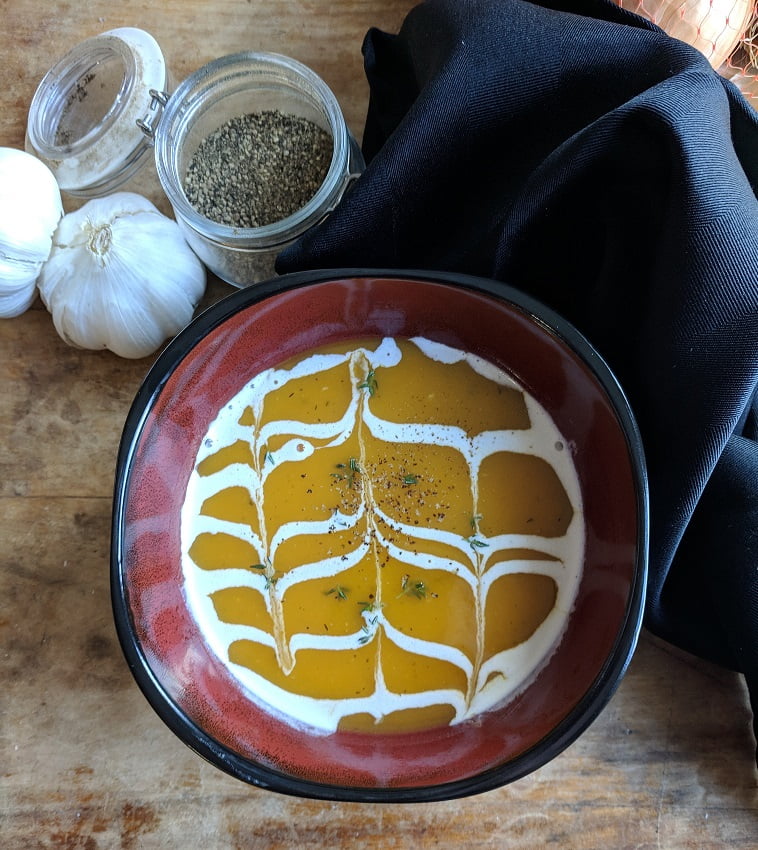This week, in my new Monday morning Segment “Getting to know” we will be getting to know butternut squash. The idea with this segment is to pick one ingredient a week and look at every aspect of it. The goal is for all of us to gain a deeper understanding of our ingredients.
What is Butternut Squash?
It may come as no surprise to you to learn that butternut squash is a member of the squash family. I mean, it’s right there in the name.
Technically a fruit, like other squashes, butternut squash is a winter squash with a sweet and buttery texture and a hard outer skin. The skin is yellowish and the flesh is a deep orange. The more ripe the squash the more orange and sweet the flesh will become.
Butternut Squash has a thin cylindrical neck and a large bulbous body which contains the fruit’s seeds. The entire fuit including skin and seeds is edible save for the stem.
Butternut Squash Uses
Because of its sweetness and texture butternut squash makes velvety puréed soups, and sauces. It can also be roasted, grilled, braised, stewed, deep-fried, steamed, or boiled.
When roasted, grilled, or steamed butternut squash holds it’s shape well and can be served as a side dish, or even tossed in salads or pastas. Boiled, it can be mashed like potatoes or puréed into a soup.
The point is that butternut squash is very versatile and delicious.
How to buy butternut squash
When buying butternut squash it should feel heavy and sound hollow when tapped on the bulb. Avoid buying a squash with soft spots or bruising. Check the stem for mold. If any is present try a different squash.
How to prepare butternut squash
There are three main ways to prepare butternut squash for cooking.
The first and most common way is to cut the neck off of the squash (across the dotted line in the picture). Once the neck has been removed the bulb is cut in half and seeds are scooped out. Then with a knife or vegetable peeler the squash is peeled, cubed and cooked.
Another common way to prepare butternut squash is to cut it in half lengthwise, scoop out the seeds, drizzle with oil, and roast in the oven. The squash is cooked when soft.
The final technique is used much less often. Essentially, you put the whole squash in the coals of a fire, rotating it every 15 minutes or so until it is cooked through.
Flavours That Go With Butternut Squash
When roasted, the flavour of the squash becomes more intense and sweeter. For this preparation a pairing of stronger flavours won’t over power the squash. Cardamom, nutmeg, cinnamon, and curry will balance well with the sweetness and intensity.
Boiled and steamed squash has more subtle flavours which can easily be buried if you’re not careful. Lemon and parmesan add a nice compliment to the squash. As does thyme, rosemary, sage, maple, and honey.
Butternut Squash Soup Recipe
Ingredients
- 1 ea Butternut Squash peeled, seeded, and diced
- 2 ea Baseball sized onions diced
- 2 ea cloves garlic roughly chopped
- 4 sprigs Thyme
- 1/2 cup Maple Syrup
- 1 L Stock or Water Enough to cover the squash by 1 inch
- 3 tbsp olive oil
- to taste salt and pepper
Instructions
- Toss the diced squash with 2 tbsp of olive oil, salt and pepper and the whole thyme sprigs.
- Spread the squash on a parchment-covered baking sheet and roast in a 400°F oven for about 40 minutes or until the squash is soft.
- Heat a large pot over medium heat and add the olive oil and diced onions.
- Cook the onions, stirring regularly, until they start to caramelize. (about 15 minutes)
- Add the garlic to the onions and cook for 2 more minutes.
- Add the maple syrup, the cooked squash, and enough stock or water to cover the squash by 1 inch.
- Simmer the soup for 10-15 minutes.
- Purée the soup with an immersion blender.
- Season to taste with salt and pepper
- For a smoother soup, pass the purée through a fine mesh sieve.






0 Comments
Trackbacks/Pingbacks